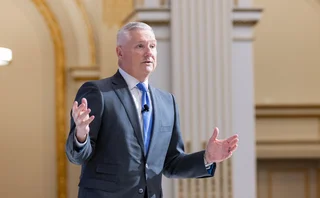
Waters Wrap: After Much Hype, Chatbots Start a New Conversation (And EU CT Ramblings)
Anthony takes a look at some interesting chatbot use cases that are beginning to bear fruit.
This edition of the Waters Weekly Wrap is going to be shorter than usual. I’m in the process of writing two stories and editing a third one that I think—I hope!—you tech and data nerds will find very interesting. As a result, my weekend will be focused on those projects. And, quite frankly, this column could use some brevity.
For more deep-dive columns, might I suggest this one on Refinitiv’s move away from Eikon and Thomson One, or this one on how/why the M&A market is heating up, or this one on causal machine learning.
Let’s Talk About Chatbots
Reb Natale has been on the chatbot beat for the last two weeks. For example, she recently spoke with Jatin Suryawanshi, head of global quantitative strategy at Jefferies, about how the investment bank is using Symphony to build out its chatbot, JEFQuants, to assist in equity trading by providing traders and PMs with real-time pre-trade information. And then last week, she listened to a presentation by Eden Kidner, CTO of equity research at Morgan Stanley, who was speaking at this year’s Symphony Innovate conference about how the bank’s AskResearch chatbot is being embedded within client-facing applications.
Building on the chatbot theme, also last week, Wei-Shen Wong nosed into Reb’s short-term beat with a story about Deutsche Bank’s chatbot, Debbie, and how the bank is planning to build it out after announcing a strategic partnership with Google Cloud. Debbie provides client trade-status information and facilitates foreign exchange workflows. (And might I suggest reading this mini-profile of how Ping An uses NLP. The Chinese banking and insurance giant is actually one of the leading NLP tech developers in the world.)
Chatbots still reside mainly in the realms of retail banking and telecom services, but advancements in the field of natural language processing (NLP) are opening up chatbots to a range of new functions, including on the trading floor. This deep-dive feature by Jo Wright explains why NLP is coming to the fore, but these recent chatbot rollouts/upgrades further illustrate a narrative I posed previously that NLP is taking on greater importance in the wholesale capital markets, rather than other sophisticated forms of AI like machine learning (much less deep learning). It would appear to me that NLP is a bit more democratized thanks to open-source tools provided by the likes of Google, Microsoft, Facebook, and OpenAI when compared with the more proprietary functions involved in ML modeling.
Additionally, those aforementioned chatbot examples from Jefferies, Morgan Stanley, and Deutsche Bank, show the importance of keeping an eye on technology developments in the retail space—bank technology often takes some time before it becomes investment bank technology, much less technology that’s filtered down to hedge funds and institutional asset managers.
So things like 5G technology and the Internet of Things (IoT), or quantum computing are likely to find more targeted use-cases on the retail side before they come to wholesale…but come to the capital markets, they will.
EU Consolidated Tape
I’ve been shooting pool (billiards, snooker) since I was a child. I’ve known good players who can make spectacular bank shots and kick shots—but that’s not the mark of an elite player. Truly elite players rarely ever put themselves into positions where they need to bank or kick. Rather, the cue ball is essentially on a string that they control, and after every shot they make, they are perfectly positioned to easily make their next shot, and the shot after that, and so on. (See: Ronnie O’Sullivan in snooker, Thorsten Hohmann in straight pool, or Shane Van Boening in 8-, 9-, or 10-ball.)
The players who don’t have a plan might look good for a while, but they’ll inevitably end up in a bad position that they can’t get out of.
Now, why am I writing about pool strategy in a fintech column (other than gratuitously mentioning my favorite pastime)? Well, in this analogy, every technology project is a match of pool: just like how you need to have a clear plan for how to get to your next series of shots, a tech project needs to have a clear plan otherwise it will end up in a bad position.
I’ve been reminded of this while reading Jo Wright’s recent coverage of a potential European Consolidated Tape, as well as Josephine Gallagher’s previous coverage of an EU CT.
As Jo wrote this week, there’s no clear direction for a CT in Europe; consensus has yet to be found for the exact need of one, or which exact problem(s) it would address. Is the cost worth the effort? Who would build it? How would it be rolled out?
At the beginning of the year, Jo and Josephine wrote about how support for an EU CT was waning—and then a pandemic turned the world completely upside down. When Mifid II was written and it include a proposition that would create a commercial consolidated tape, it was assumed companies would willingly come forward to take up the mantle. But two-and-a-half years later, not a single company has emerged as a consolidated tape provider in any asset class.
Jo, in a column published earlier this month, explained why this process has been so challenging:
“There are two main obstacles to the tape at this point. First, there are concerns around data quality, with market participants saying that Approved Publication Arrangements, which would have to contribute data to the tape, don’t follow the regulators’ technical standards, and that there is inconsistent reporting of trades conducted via systematic internalizers or over-the-counter. After all, there’s no point in a consolidated tape if the data is not consistent and of high quality. The other obstacle is probably more urgent because it is foundational, and it’s this: the best governance and commercial model for the consolidated tape provider (CTP) is now in question, as, clearly, becoming a CTP is not an enticing prospect to any commercial companies.”
The history of capital-markets technology is replete with projects that promise the world in terms of efficiency, but require up-front investment to make them a reality. Few end up achieving those goals.
I’m certainly not an expert on the topic of consolidated tapes—or, for that matter, much of any subject outside of pool strategy—but it seems like the EU regulators, through Mifid II, fired off their first shot (the idea of a consolidate tape), but had absolutely no plan for how that series of next shots would end up in the sinking of the 8-ball (in this case, the creating and completion of an EU CT). And now, they’re stuck.
Tired of strained pool analogies? Fine. I’m done anyway. See you all next week.
The image at the top of the page is Alexandre Bida’s “Young Greek Man in Conversation with a Priest” courtesy of the Cleveland Museum of Art.
Further reading
Only users who have a paid subscription or are part of a corporate subscription are able to print or copy content.
To access these options, along with all other subscription benefits, please contact info@waterstechnology.com or view our subscription options here: http://subscriptions.waterstechnology.com/subscribe
You are currently unable to print this content. Please contact info@waterstechnology.com to find out more.
You are currently unable to copy this content. Please contact info@waterstechnology.com to find out more.
Copyright Infopro Digital Limited. All rights reserved.
You may share this content using our article tools. Printing this content is for the sole use of the Authorised User (named subscriber), as outlined in our terms and conditions - https://www.infopro-insight.com/terms-conditions/insight-subscriptions/
If you would like to purchase additional rights please email info@waterstechnology.com
Copyright Infopro Digital Limited. All rights reserved.
You may share this content using our article tools. Copying this content is for the sole use of the Authorised User (named subscriber), as outlined in our terms and conditions - https://www.infopro-insight.com/terms-conditions/insight-subscriptions/
If you would like to purchase additional rights please email info@waterstechnology.com
More on Data Management
FactSet looks to build on portfolio commentary with AI
Its new solution will allow users to write attribution summaries more quickly and adds to its goal of further accelerating discoverability, automation, and innovation.
How Ally found the key to GenAI at the bottom of a teacup
Risk-and-tech chemistry—plus Microsoft’s flexibility—has seen the US lender leap from experiments to execution.
The IMD Wrap: Beginning of the end for data audits?
This week, there’s exciting news for data bean-counters in the form of a partnership between two vendors that could change the way we view and track data usage and audits.
Symphony boosts Cloud9 voice offerings with AI
The messaging and collaboration platform builds on Cloud9’s capabilities as it embraces the AI wave in what CEO Brad Levy calls “incremental” steps.
MSCI counts the cost of bank M&A, looks ahead to custom indexes, AI
Cancellations of overlapping contracts following a bank merger put a dent in MSCI’s earnings, but management remains upbeat about the potential of recent acquisitions and new technology developments.
Nasdaq reshuffles tech divisions post-Adenza
Adenza is now fully integrated into the exchange operator’s ecosystem, bringing opportunities for new business and a fresh perspective on how fintech fits into its strategy.
This Week: HKEx's new derivatives platform; GoldenSource; Quonian-SimCorp, and more
A summary of some of the latest financial technology news.
Chris Edmonds takes the reins at ICE Fixed Income and Data Services
Edmonds is now leading ICE’s fixed income and data business as the rush to provide better data and analytics in fixed income builds.
Most read
- Chris Edmonds takes the reins at ICE Fixed Income and Data Services
- Nasdaq reshuffles tech divisions post-Adenza
- Deutsche Börse democratizes data with Marketplace offering








